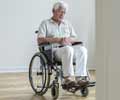Peripheral nerves in the upper arms of a patient suffering peripheral nerve damage have been successfully rescued by a team of researchers using skin-derived stem cells and a collagen tube

Although autologous nerve grafting has been the 'gold standard' for reconstructive surgeries, these researchers felt that there were several drawbacks to that approach, including graft availability, donor site morbidity, and neuropathic pain.
According to the researchers, autologous SDSCs have advantages over other stem cells as they are an accessible source of stem cells rapidly expandable in culture, and capable of survival and integration within host tissues.
While the technique of using the collagen tubes - NeuraGen, an FDA-approved device - to guide the transplanted cells over gaps in the injured nerve had been previously developed and tested by the same researchers with the original research successfully saving damaged sciatic nerves on rats, the present case, utilizing the procedure they developed employing SDSCs and a nerve guide, is the first to be carried out on a human.
Over three years, the researchers followed up on the patient, assessing functional recovery of injured median and ulnar nerves by pinch gauge test and static two-point discrimination and touch test with monofiliments along with electrophysiological and MRI examinations.
"Our three-year follow up has witnessed nerve regeneration with suitable functional recovery in the patient and the salvage of upper arms from amputation," said the researchers. "This finding opens an alternative avenue for patients who are at-risk of amputation after the injury to important nerves."
Advertisement
Advertisement











